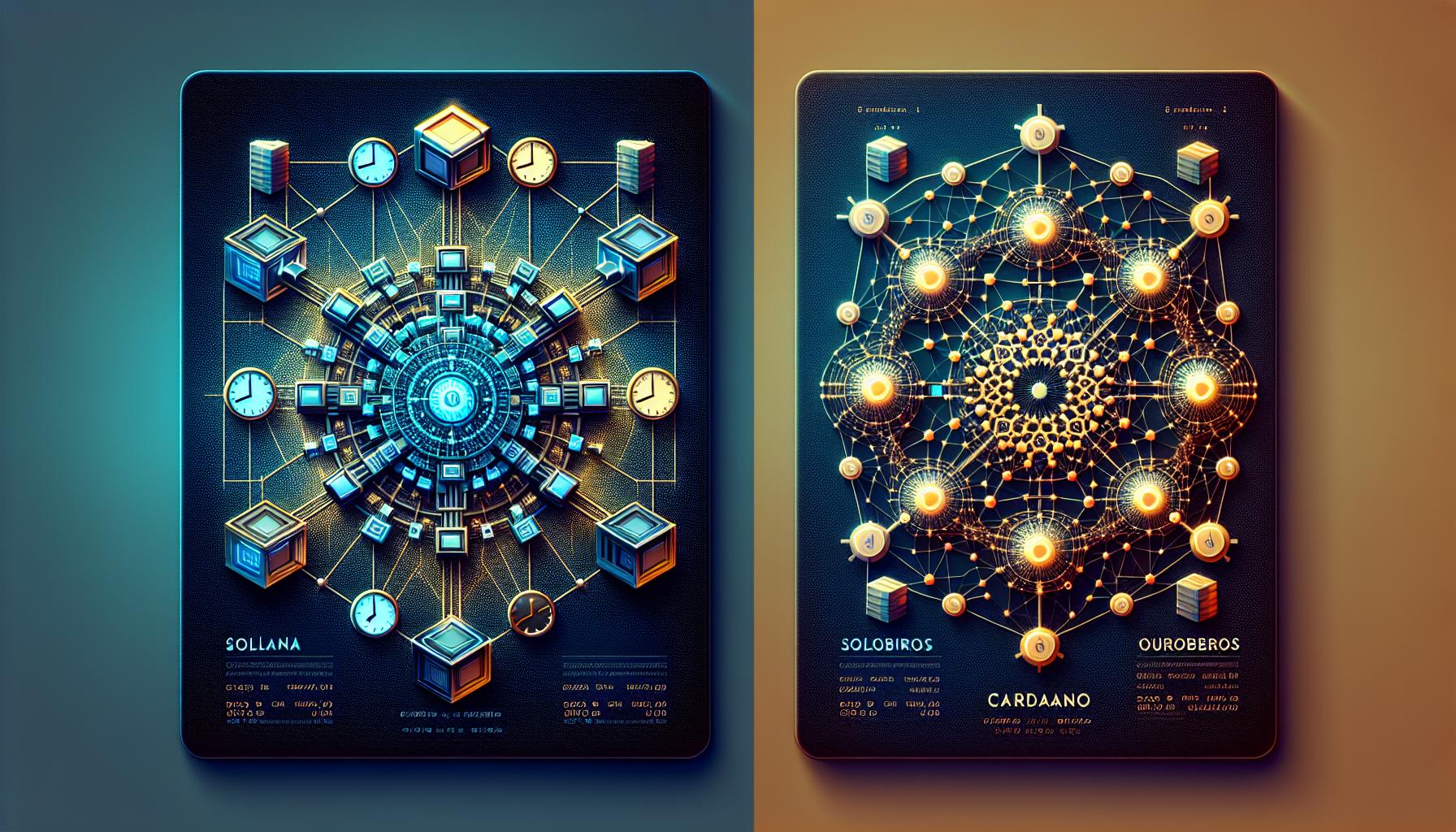If you’re diving into the world of cryptocurrencies, you’ve likely encountered the buzz surrounding Solana and Cardano. These two blockchain platforms have been making waves in the digital asset space, each offering unique features and capabilities that set them apart from the crowd. Solana, known for its high-speed transactions and low fees, has garnered attention for its scalability and performance. On the other hand, Cardano has been praised for its focus on sustainability and academic research-driven approach to blockchain development. As you navigate the complexities of these platforms, understanding the key differences and strengths of Solana and Cardano can help you make informed decisions in the ever-evolving crypto landscape.
Overview of Solana and Cardano
When comparing Solana and Cardano in the world of cryptocurrencies, it’s essential to understand their unique characteristics that set them apart. Solana is known for its high-speed transactions and low fees, focusing on scalability and performance. On the other hand, Cardano stands out for its sustainability focus and academic research-driven approach to blockchain development. By examining the strengths of both Solana and Cardano, you can make informed decisions within the ever-changing cryptocurrency landscape.
Consensus Mechanism Comparison

When comparing Solana and Cardano, it’s essential to understand their consensus mechanisms. Solana relies on a permissionless Proof of History (PoH) combined with a Proof of Stake (PoS) consensus model. This unique approach prioritizes scalability, enabling high-speed transactions at an impressive throughput of up to 65,000 transactions per second. In contrast, Cardano utilizes the Ouroboros PoS protocol, known for its security and sustainability features.
Solana’s Consensus Mechanism:
- Solana’s PoH acts as a clock for the blockchain, timestamping transactions efficiently.
- PoS validators are selected based on the number of tokens staked, ensuring a decentralized network.
- By leveraging PoH alongside PoS, Solana achieves high performance without compromising on security.
- Cardano’s Ouroboros algorithm divides time into epochs and slots for block creation.
- Validators are elected based on their stake and play a crucial role in securing the network.
- Cardano’s focus on peer-reviewed research enhances the protocol’s resilience and reliability.
While Solana emphasizes speed and scalability through its PoH and PoS hybrid mechanism, Cardano prioritizes security and sustainability with the Ouroboros PoS protocol. Understanding the intricacies of these consensus mechanisms is key to grasping the core strengths of each blockchain platform.
Transaction Speed and Scalability
When comparing Solana and Cardano in terms of transaction speed and scalability, it’s evident that both blockchains have distinct approaches.
Solana
Solana’s architecture focuses on high-speed transactions and scalability. It employs a unique consensus mechanism known as Proof of History (PoH) combined with Proof of Stake (PoS). This innovative approach allows Solana to achieve exceptional throughput levels of up to 65,000 transactions per second. By leveraging PoH and PoS, Solana prioritizes speed and scalability, making it a preferred choice for users requiring rapid transaction confirmations and high network throughput.
Cardano
In contrast, Cardano emphasizes security and sustainability in its blockchain design. Utilizing the Ouroboros Proof of Stake (PoS) protocol, Cardano ensures robust security features and sustainable network operation. While Cardano may not match Solana’s transaction speeds, its focus on security and sustainability appeals to users looking for a reliable and secure blockchain network.
Comparison
In the realm of transaction speed and scalability, Solana’s emphasis on high throughput sets it apart from Cardano’s focus on security and sustainability. Depending on your priorities—whether you value speed and scalability or prioritize security and sustainability—choosing between Solana and Cardano will depend on which aspects align best with your blockchain needs.
Smart Contract Functionality
When considering smart contract functionality, Solana and Cardano have distinct approaches that cater to different priorities in the cryptocurrency realm.
Solana’s Smart Contracts
Solana’s smart contract functionality is built on its high-speed and cost-effective design. The platform utilizes a combination of Proof of History (PoH) and Proof of Stake (PoS) mechanisms to achieve high throughput and low latency. This design allows Solana to process a large number of transactions quickly and efficiently, making it an attractive option for users looking for rapid transaction speeds.
Cardano’s Smart Contracts
On the other hand, Cardano focuses on security and sustainability in its smart contract functionality. With the Ouroboros Proof of Stake (PoS) protocol, Cardano ensures that transactions on its blockchain are secure and environmentally friendly. While Cardano may not prioritize transaction speed as much as Solana, it offers a robust and research-driven approach to smart contract execution.
Choosing the Right Platform
When choosing between Solana and Cardano based on smart contract functionality, it’s essential to consider your priorities. If you value high-speed transactions and cost-effectiveness, Solana’s approach may align better with your needs. Conversely, if security and sustainability are your main concerns, Cardano’s smart contract design offers a more comprehensive solution.
Understanding the smart contract functionality of Solana and Cardano is crucial for determining which blockchain platform suits your requirements in the dynamic cryptocurrency landscape.
Decentralization and Governance
When comparing Solana and Cardano in terms of decentralization and governance, there are distinct differences in how each blockchain network operates.
Solana:
Solana prides itself on its approach to decentralization through its consensus mechanism. By utilizing Proof of History (PoH) and Proof of Stake (PoS), Solana can achieve high throughput while maintaining security and efficiency. In terms of governance, Solana’s governance model involves stakeholders who actively participate in decision-making processes. This decentralized governance structure ensures that the network remains secure, transparent, and adaptable to the evolving needs of its ecosystem.
Cardano:
On the other hand, Cardano focuses on a research-driven approach to decentralization and governance. With the Ouroboros Proof of Stake (PoS) protocol, Cardano ensures a secure and sustainable blockchain network. Cardano’s governance model aims to involve the community in decision-making processes, emphasizing transparency and inclusivity. This approach allows Cardano to adapt to changing dynamics while maintaining a decentralized ecosystem.
While Solana emphasizes high throughput and efficiency through its unique consensus mechanism, Cardano prioritizes security and sustainability in its governance model. Understanding these differences in decentralization and governance can help you choose the blockchain platform that aligns best with your priorities and values in the cryptocurrency landscape.
Security Features
When considering the security features of Solana and Cardano, it’s crucial to examine the mechanisms that underpin the safety and integrity of these blockchain platforms. Both Solana and Cardano prioritize security, albeit through different approaches.
Solana Security Features
Solana, known for its high throughput and efficiency in transactions, implements a range of security features to safeguard its network. One key security aspect of Solana is its use of the Proof of History (PoH) consensus mechanism. This innovative approach helps prevent various attacks, enhancing the overall security of the network.
Additionally, Solana employs a Proof of Stake (PoS) mechanism, which further fortifies the security of the platform. By combining PoH and PoS, Solana ensures not only rapid transaction speeds but also robust security measures that make it a reliable choice for users concerned about safety in the digital landscape.
Cardano Security Features
On the other hand, Cardano distinguishes itself with a focus on security and sustainability. Utilizing the Ouroboros Proof of Stake (PoS) protocol, Cardano enhances security by incorporating a research-driven approach to validate transactions. This protocol ensures that transactions are secure and resistant to potential attacks, making Cardano a preferred choice for users seeking a secure blockchain platform.
Cardano’s emphasis on security is further bolstered by its commitment to sustainability, ensuring that the network remains secure and reliable in the face of evolving threats in the competitive digital world. By prioritizing security and sustainability, Cardano provides users with a secure environment for their transactions and activities.
In comparing the security features of Solana and Cardano, it’s evident that both platforms prioritize the safety and integrity of their networks. Whether you prefer Solana’s innovative approach with PoH and PoS or Cardano’s focus on security and sustainability with the Ouroboros PoS protocol, understanding these security features is essential in choosing the right blockchain platform for your needs in today’s digital landscape.
Conclusion
When comparing Solana and Cardano, it’s evident that both platforms offer unique strengths that cater to different needs in the cryptocurrency space. Solana stands out with its impressive speed and cost-effectiveness, thanks to its innovative Proof of History (PoH) and Proof of Stake (PoS) mechanisms. On the other hand, Cardano shines with its sustainability focus and research-driven approach, utilizing the Ouroboros PoS protocol for security and sustainability. Understanding these distinctions is crucial in selecting the right blockchain platform for your specific requirements. Whether you prioritize speed and efficiency or security and sustainability, both Solana and Cardano provide robust options for secure transactions and decentralized governance. Ultimately, the choice between Solana and Cardano depends on your priorities and objectives in the evolving landscape of digital currencies.
Frequently Asked Questions
What makes Solana popular in the cryptocurrency realm?
Solana is popular due to its exceptional speed and cost-effectiveness, supported by the innovative use of Proof of History (PoH) and Proof of Stake (PoS) for high throughput.
Why is Cardano preferred by many in the crypto community?
Cardano stands out for its sustainability and research-driven approach, utilizing the Ouroboros PoS protocol for security and long-term viability.
How do Solana and Cardano differ in their consensus mechanisms?
Solana employs PoH and PoS for high throughput, while Cardano utilizes the Ouroboros PoS protocol for security and sustainability.
What are the main considerations when choosing a blockchain platform between Solana and Cardano?
Understanding the differences in speed, cost-effectiveness, security, and sustainability is crucial for selecting the most suitable blockchain platform.
How do Solana and Cardano approach decentralization and governance?
Solana involves stakeholders in decision-making processes, whereas Cardano prioritizes community involvement and transparency for governance.
What security features do Solana and Cardano offer to users?
Solana ensures security and efficiency through PoH and PoS, while Cardano emphasizes security and sustainability with the Ouroboros PoS protocol.








